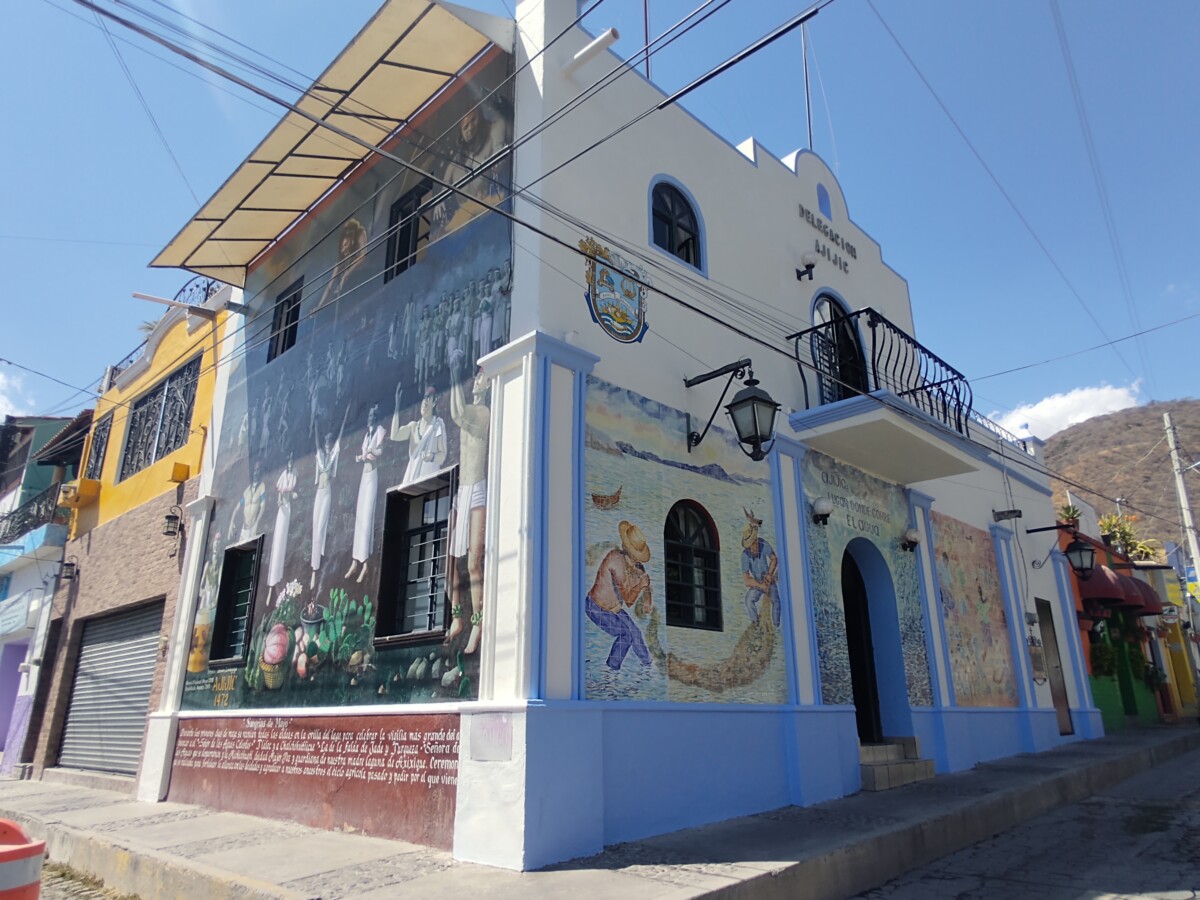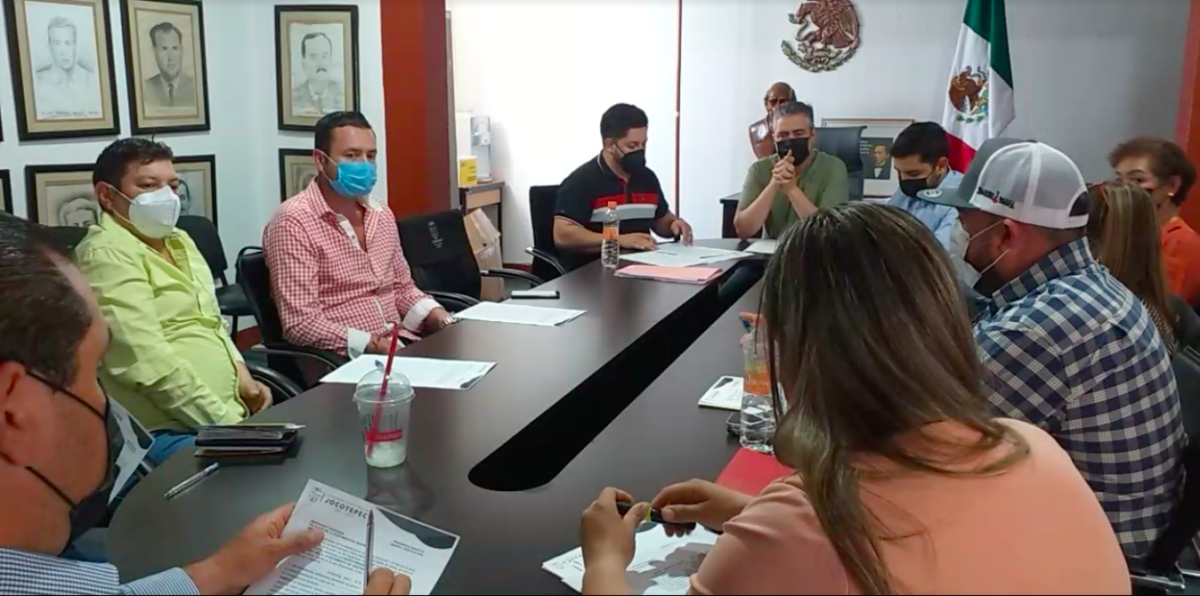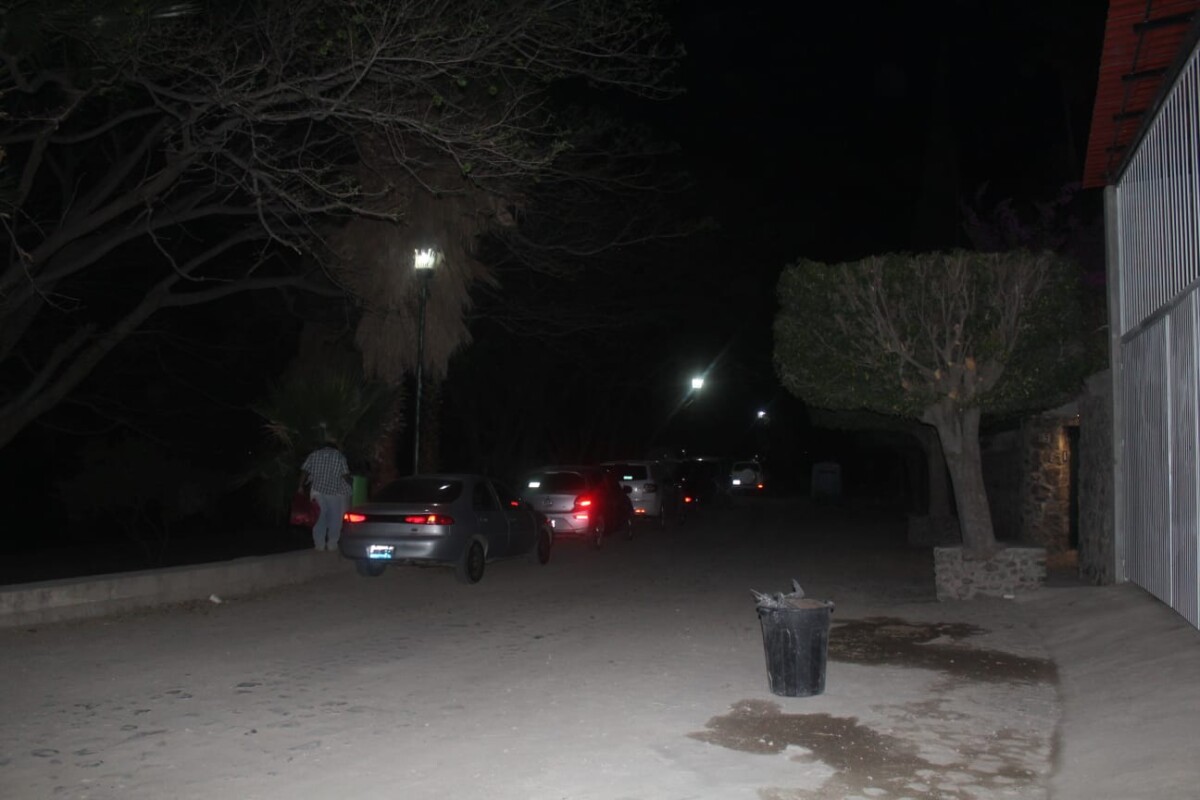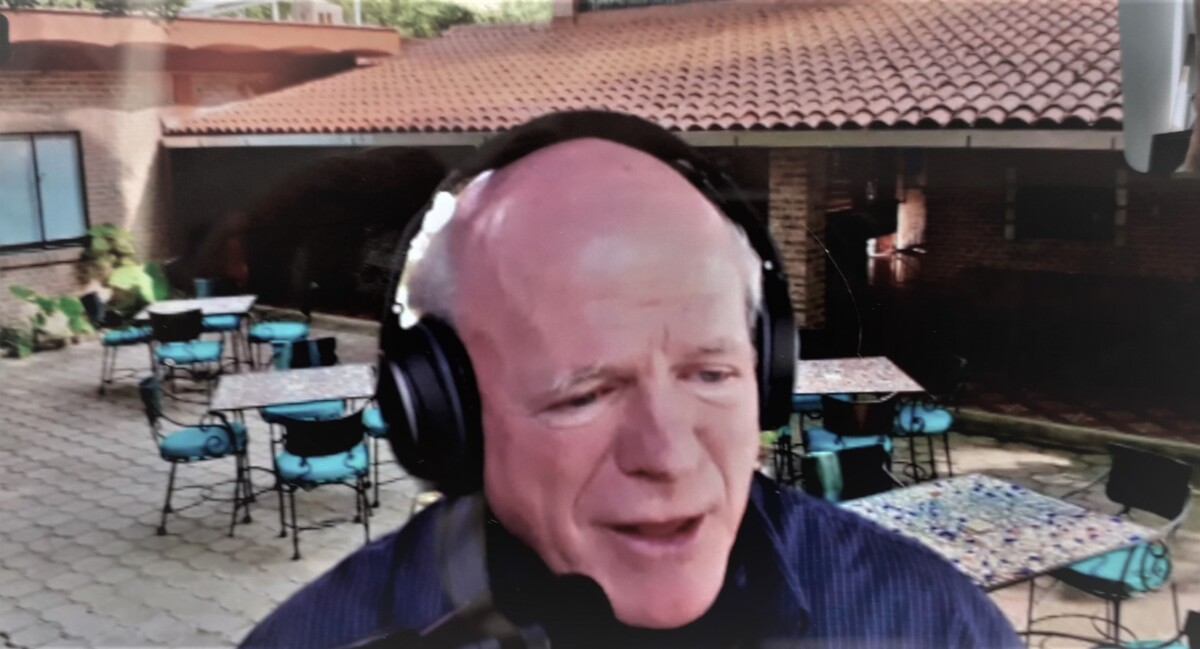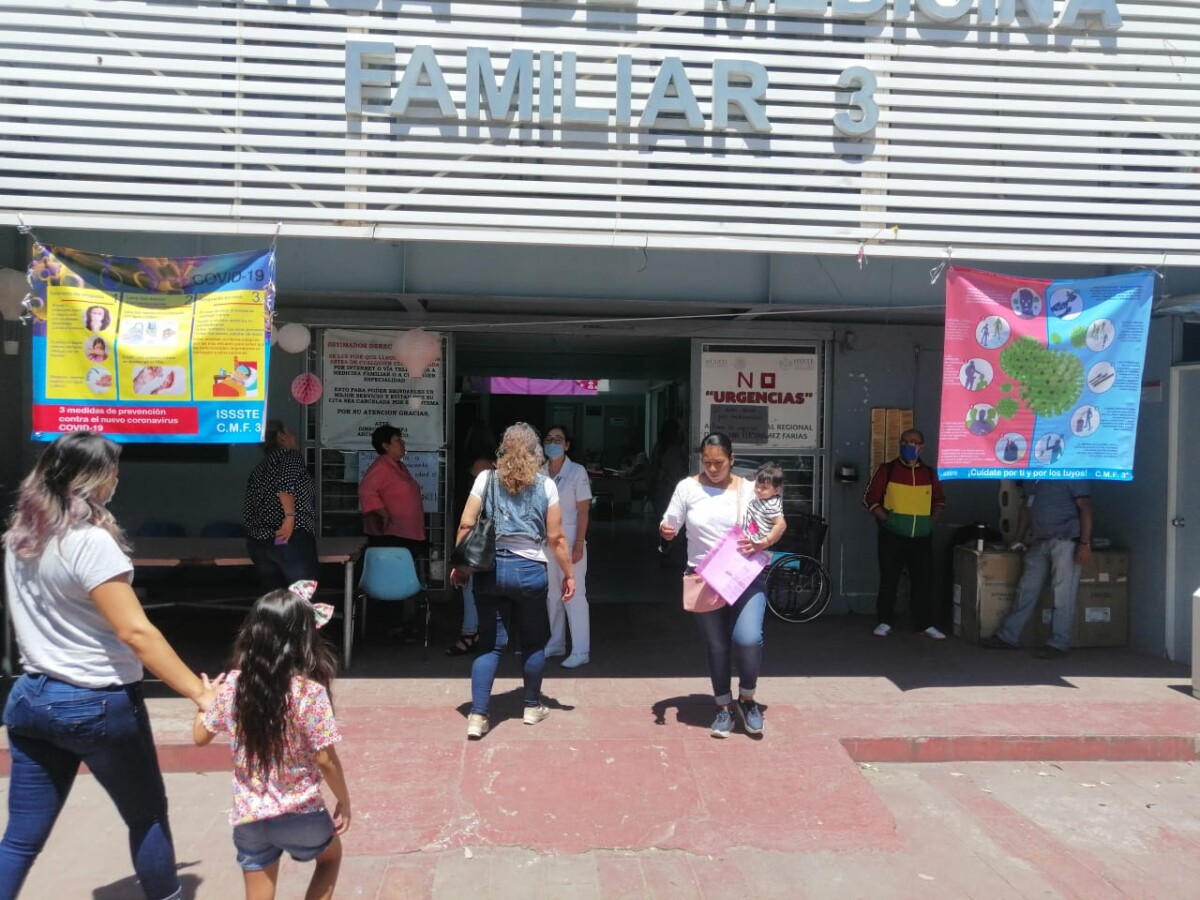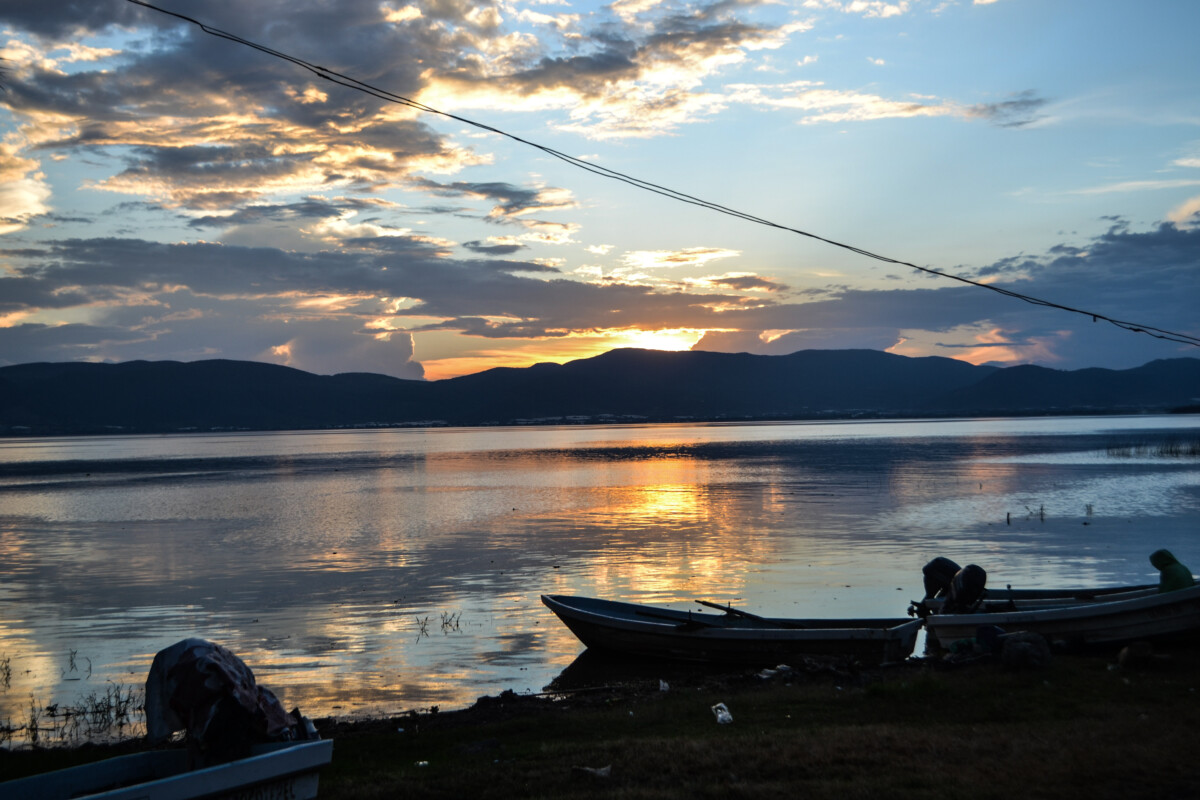municipio
Residents criticize change of color in the Ajijic police station
The building of the Ajijic delegation was repainted blue. Photo: Sofía Medeles.
Sofía Medeles(Ajijic).- The new look of the Ajijic delegation building, which began to be painted last week, has generated controversy and diverse opinions among citizens, due to the color used: blue.
The acting delegate, Maximiliano Macias Arceo, said that he is aware of the opinions, both positive and negative, that this change has caused. He commented that the color was chosen from a range of colors suggested by the State Government for Pueblos Magicos venues, among which were dark greens, browns and cream colors, in addition to two shades of blue.
In social networks and in daily conversations of Ajijic residents, there have been diverse opinions about the new painting among those who support the remodeling and those who did not like the change.
«The government just changed political parties and now they change the color of everything to match. So far the malecon, the cemetery and now the police station. They say they are different tones, but the intention is clear. As a Magic Town, they should regulate this change of colors more. Besides, it would be better to invest in fixing streets, street lights, planters, etc., instead of spending liters and liters of blue paint,» commented Antonio.
In contrast, many other residents agree with the modification. «As long as they paint and show a neat image to tourists, it’s fine, that’s what many of us live on. It is something that has to be done and, in my opinion, this new color is in accordance with Ajijic, because it is a place where water abounds in the historical and cultural aspects», expressed Luis.
Finally, Macias Arceo commented that the moldings of the mural that is on the wall of Hidalgo Street, still need to be painted a color that harmonizes with it. Still missing in the main facade of the painting is the upper part, in addition to the shield of the delegation and the logo of Ajijic Magic Town.
Translated by Sydney Metrick
Families of the two murdered Jocotepec policemen will receive 100 percent of their pension
The city council approved to cover 100 percent of the pension of the policemen killed in the confrontation on March 10. Photo: Social Networks.
The Jocotepec City Council approved a proposal to grant 100 percent of the pension to the families of the two policemen killed in an armed attack on March 10.
During the fifth ordinary session of the council, held on Thursday, March 17, the council members observed a minute’s silence in honor of the security officers who died in the line of duty before discussing the pension to be granted to the bereaved.
Municipal trustee Carlos Alberto Zúñiga Chacón said that, according to the reports issued by the labor office based on the seniority of the officers, the corresponding pension would be 30 percent. Edgar Omar Leal Nava had been serving in the force for two years and three months, while Andrés Inclán Zamora had only 52 days.
However, due to the heroic performance of their work and the situation in which they died, municipal president José Miguel Gómez López proposed that it be increased to 100 percent.
«They were behaving like heroes, without weapons, without equipment. It’s the least we as public servants can do,» commented Gómez López.
The initiative was approved unanimously. A monthly amount of 10,500 pesos will be given to the families of those affected, which will be divided equally among the children of each police officer. The pension will be delivered until the last of their descendants reaches the age of majority.
Finally, the municipal president also assured that, after the unfortunate events, «It will be necessary to make a front to pressure the state and federal authorities,» to provide more economic support and to be able to adequately equip the public security officers.
The policemen were killed while responding to an accident near San Cristóbal Zapotitlán on the evening of Thursday, March 10. Two paramedics, a man and a woman attending the accident, were also injured in the aggression.
Translated by Sandy Britton
Disagreements over street lighting in La Crucita neighborhood of Ajijic
Del Paseo Street has several streetlights some say it’s insufficient. Photo: Sofía Medeles.
Sofía Medeles(Ajijic).- Residents disagree on street lighting in the La Crucita area, located two blocks from the Ajijic boardwalk. The area has several functioning street lights, but some concerned citizens say there still isn’t enough light on the street. However, one couple is annoyed by the strength of the existing lights.
Acting delegado Maximiliano Macias Arceo commented that a couple living at the intersection of Nicolas Bravo and Del Paseo, are disturbed by the lights. «There is a big problem with those people who are bothered by the light. They’ve bought a device to turn off the lights at a certain time, though I believe it has not been used. They were told that they cannot do that, since it is a public road. Other neighbors requested the lights to prevent people from staying there drinking alcoholic beverages until late hours or throwing garbage.»
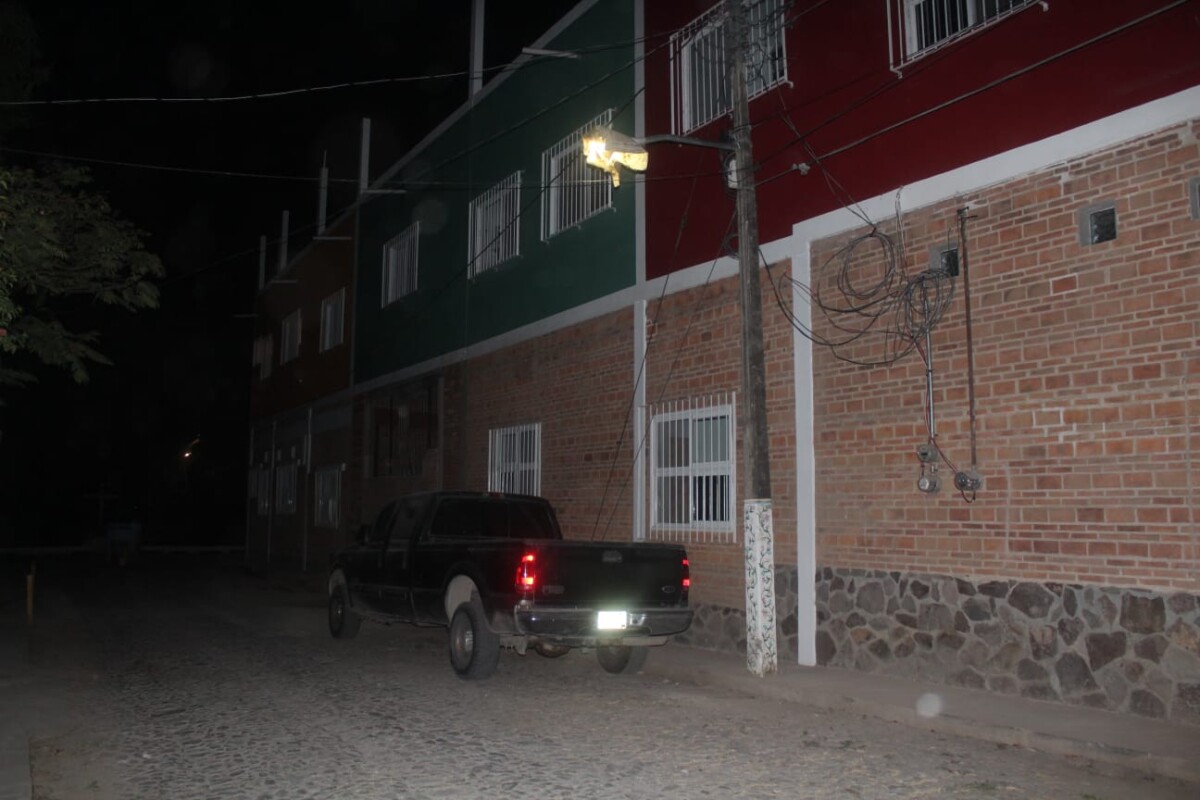
Neighbors covered a streetlight on Nicolás Bravo Street. Photo: Sofía Medeles.
People passing through the area also complain about the lack of lighting. The last administration gave permission to cover a streetlight on Nicolás Bravo Street, a few meters from the area of La Crucita, because it bothered the couple in question. It now offers very little light.
In a tour by Semanario Laguna, there were at least four lamps on Del Paseo street and two in the beach area. Despite this, the area is still very dark. Four passersby were asked what they thought of the lighting, and they agreed that it is insufficient.
For his part, Macías Arceo stated that his intention is to put more lamps in the area, since there is a lot of traffic both on the beach and in the street. After a recent cleanup, more people make use of the space. He also stated that anyone installing a timer would be subject to a sanction.
Translated by Elisabeth Shields
Pide Estados Unidos a ciudadanos reconsiderar viajes a Jalisco
Por la ola de violencia registrada en Jalisco, Estados Unidos pidió a sus ciudadanos reconsiderar sus viajes. Foto: Cortesía.
Redacción.- El Gobierno de Estados Unidos invitó a sus ciudadanos a reconsiderar visitar Jalisco, debido a la alta incidencia delictiva; la medida no aplica para Chapala y Ajijic.
A través de un aviso en la página www.travel.state.gov, se indicó que la entidad registra un incremento en delitos violentos, además de disputas entre el crimen organizado; por lo que pidió a sus connacionales, extremar precauciones.
Asimismo, se señaló que ciudadanos norteamericanos han sido víctimas de secuestro en Jalisco, especialmente en la zona fronteriza con el vecino estado de Michoacán.
Por su parte, los empleados del gobierno de Estados Unidos tienen prohibido transitar por la frontera del estado, por la carretera 80 al sur del municipio de Cocula y por la estatal 544 ubicada entre los municipios de San Sebastián del Oeste y Mascota.
En contraste, la recomendación de viaje no aplicó para la Zona Metropolitana de Guadalajara, Puerto Vallarta, Chapala y Ajijic.
LCS Annual General Meeting is a “State of the Union” for LCS
LCS Chairman Stephen Balfour conducts a hybrid live and zoom Annual General Meeting from the terrace of LCS. (screen shot)
Patrick O’Heffernan (Ajijic).- The Lake Chapala Society’s Annual General Membership meeting held Tuesday, March 15, was a “state of the union” for one of Lakeside’s largest and most influential non-profit organizations. According to Board Chair Stephen Balfour who led the hybrid live/ zoom meeting.
After a highly produced video tour hosted by Balfour and Executive Director Luis Pacheco with cameos by members of the LCS staff, the Annual Membership Meeting ( AGM) was called to order with 83 people in attendance online and in person at the LCS campus in Ajijic. The tour covered the grounds of the campus and the many improvements that have taken place over the past 723 days since the last in-person AGM.
Highlights of the near 2-hour long meeting included reelection of the existing Board members, election of Choosing Mexico CEO Greg Custer for an at-large Board seat, the introduction of the Mexican Advisory Council led by Cruz Roja Chair Yolanda Martínez Llamas, the renaming of the LCS docents as “LCS Amigos”.
Balfour and new Executive Director Pacheco, the Mexican to run the organization, took the members through the challenges and the accomplishments of the past 723 days, noting that for a while the work of the staff was focused solely on keeping the doors open as membership plummeted by 40% due to Covid.
To pay the bills and keep the staff working, Balfour used his experience as a concert producer in the US to launch the Concerts in the Park series at LCS which raised $2.2 million pesos for LCS and $1 million for Cruz Roja. Additional restricted funds were raised from major donors to purchase the Molenari/West Annex property in November of last year. That combined with $3million pesos in increased donations offset the loss of program income and much dues income to enable LCS to stay open, purchase an adjacent property, and refurbish much of the grounds.
Balfour reported that visitation is up to 1000 a week now, with 40,000 people coming through the doors last year, an indication that the members are returning and engaging in the 100 programs now operating at LCS.
The AGM also included a financial report to the members, informing them that LCS’s financial condition is good, with a cash reserve of $850,000 and an operating deficit of $14,395 which was necessary to complete necessary repairs and maintenance, and a net asset valuation of $30 million.
The final segment of the AGM was dedicated to LCS 2.0, the plan developed and approved by the Board to guide the next decade of LCS. Balfour stressed that he wants LCS to be known for “customer service” . He also listed other priorities as a closer relationship with the Mexican community, continuing to strengthen the bonds with the Instituto Tecnológico Superior De Chapala , and broadening fundraising through innovations like new, smaller, flexible-use “named” tables members can sponsor for $6000 pesos.
The 2022 budget projects $7,009,100 MX in expenses and revenue, with annual dues remaining unchanged from the current $830MX a year for singles and $650nMX for persons age 79 and over in 2022.
ISSSTE seeks medical office in Chapala
ISSSTE members must continue traveling to the Family Medicine Clinic 3 in Guadalajara for consultations and their medicines, while the Chapala City Council locates an office to provide for medical care.
Editor- After almost two years without medical care in Chapala, the beneficiaries of the Institute of Social Security and Social Services for Workers (ISSSTE), Jalisco Delegation, now have an attending doctor in the municipal seat; however, there is still no clinic for that doctor to provide medical attention.
That is why Elpidio Yáñez Rubio, Secretary General of Section 16 of the National Union of Education Workers (SNTE), sought out the Mayor of Chapala, Alejandro de Jesús Aguirre Curiel, to request a space for a medical clinic.
At the March 3 meeting, the City of Chapala agreed to search out three available locations for a clinic. Those locations will be evaluated by the municipal authorities so that medical services for ISSSTE’s members can be re-established.
Elpidio Yáñez acknowledged the current lack of a hospital to provide medical care and promised to conduct a census of ISSSTE beneficiaries to determine the feasibility of the construction of a medical clinic in Chapala.
Before his resignation in July 2020, ISSSTE medical attention in Chapala and surrounding municipalities had been provided by medical surgeon César Flavio Ibarra Soltero for 21 years.
Translated by MaryAnne Marble
Entrega Gobernador de Jalisco ciclovía y supervisa obras durante su visita a Chapala
Alejandro de Jesús Aguirre Curiel junto al gobernador Enrique Alfaro durante la entrega de los 16 kilómetros terminados de la ciclopista Chapala – Jocotepec. Foto: Jazmín Stengel.
Jazmín Stengel.- Cuatro obras, entre supervisión y entregas son las que presentó el Gobernador de Jalisco, Enrique Alfaro Ramírez, durante su gira por Chapala, acontecida el viernes 25 de marzo.
El proyecto de la ciclovía de Chapala que abarca 16 kilómetros fue entregado de manera oficial el mismo día, frente al parque La Milagrosa. La obra inició durante la administración pasada 2018-2021, el presupuesto total, hasta Jocotepec fue de 211 millones de pesos, aseguró el gobernador.

Enrique Alfaro y el presidente municipal de Chapala, Alejandro de Jesús Aguirre Curiel, durante la supervisión de obra en la Telesecundaria Guadalupe Victoria en Santa Cruz de la Soledad, un alumno leyó un agradecimiento al respecto. Foto: Jazmín Stengel.
Enrique Alfaro y el presidente municipal de Chapala, Alejandro de Jesús Aguirre Curiel, durante la supervisión de obra en la Telesecundaria Guadalupe Victoria en Santa Cruz de la Soledad, un alumno leyó un agradecimiento al respecto.
También se realizó la grabación de un video para presentar el proyecto de imagen urbana en la entrada de Chapala, es decir, la obra de rehabilitación planeada para la avenida Francisco I. Madero en la cabecera municipal, cuya inversión consta de 17.5 millones de pesos para la primera etapa y aproximadamente 80 millones más en la segunda. Se estima que la obra tardará dos años en terminarse.
Los dos proyectos supervisados son la extensión de la Telesecundaria Guadalupe Victoria en Santa Cruz de la Soledad con un presupuesto de 12.9 mdp y un nuevo módulo en el Instituto Tecnológico de Chapala, Mario Molina con una inversión ya asignada de 25 millones más 15 millones que el gobernador anunció durante la gira.
La primera etapa de la ciclopista que constó de 8 kilómetros desde Chapala hasta Ajijic fue entregada por el Gobernador en el mes de agosto del 2020 a la administración 2018-2021.
Busca la nota completa en nuestra siguiente edición impresa.
OPINIÓN: EL GRITO EN LA LAGUNA
Lago de Chapala. Foto: Hector Ruiz
Por: Daniel Jimenez Carranza
Uno de los factores definitivos que juega un papel relevante en todas las sociedades es la regulación de su crecimiento, el cual en nuestro país no ha sido considerado con la suficiente seriedad como tal, existe una figura administrativa dentro de la organización de los Ayuntamientos, como es la oficina, departamento o dirección de desarrollo urbano la cual en la mayoría de los casos, únicamente se dedica a “regular el tipo de construcciones”, que en muchos casos no cumplen completamente con los lineamientos contenidos dentro del Plan de Desarrollo Urbano de la localidad, y cuyos criterios al momento de autorización de construcciones, son bastante elásticos, dependiendo de múltiples factores como son los económicos, políticos y de amiguismo. En otros casos, los lineamientos no son lo suficientemente claros y precisos, que propician en el mejor de los casos, un desorden de las construcciones en la localidad y en otros, lamentables accidentes por las características del suelo y construcciones inapropiadas.
Todo ello, sin embargo, es sólo un aspecto de tantos otros que deben ser considerados en el control del desarrollo urbano, como son los recursos de la localidad tanto humanos como materiales, las instalaciones, equipo e infraestructura, la distancia hacia los centros de consumo y de producción, características de la población, etc., todos estos factores permitirán realizar un plan integral realista que aporte bienestar a la comunidad, que regule el crecimiento de la población y que permita la conservación del ecosistema entre otros importantes aspectos.
La unidad de desarrollo urbano, debe estar integrada por diferentes especialistas cuyas aportaciones incidan y regulen el propósito enunciado, protegiendo el interés común y propiciando un desarrollo claramente concebido y coherente para ese propósito.
La falta de un plan integral, trae como consecuencia, múltiples disfunciones sociales, ecológicas, arquitectónicas, asi podemos observar construcciones monumentales a la orilla del lago, totalmente inapropiadas, desarrollo de actividades ganaderas en zonas residenciales, como es el caso del terreno localizado en la calle Río Chamela, en Rancho del Oro, supuestamente propiedad del Gobierno del Estado que contribuye a crear un aspecto reprobable de espacios improvisados con plásticos superpuestos, que generan basura al interior y exterior del terreno, desconociendo que una institución de tal calibre comercie con el alquiler de una propiedad oficial para este propósito, aunque de acuerdo con el Plan Parcial, ello es una zona mixta que permite esta actividad, que aún justificada, desconocemos quien lucra y se beneficia de ellas.
Tratándose de un activo del Estado, el Ayuntamiento tendría que gestionar la donación del terreno para un mejor propósito que beneficie al municipio, como la construcción de un campo deportivo, parque de usos múltiples, particularmente importante para un país con una población juvenil considerable y gran déficit de instalaciones para este grupo.
Alfaro da banderazo e inaugura obras en Jocotepec
El Gobernador de Jalisco, Enrique Alfaro Ramírez, en compañía del presidente municipal de Jocotepec, José Miguel Gómez López y la diputada local, María Dolores López Jara, dando el banderazo de inicio de obra del libramiento. Foto: Héctor Ruiz.
Héctor Ruiz Mejía.- El gobernador de Jalisco, Enrique Alfaro Ramírez, realizó un recorrido el pasado 25 de marzo por distintos puntos de la Ribera de Chapala, entre ellos, Jocotepec.
Durante su visita, Alfaro Ramírez inauguró el Centro de Salud de San Cristóbal Zapotitlán, cuyo costo fue de 10 millones de pesos.
También supervisó la última etapa de la ciclovía que conectará a San Juan Cosalá con la cabecera y que concluirá en mayo. La inversión total de la vía recreativa que conectará a Chapala y Jocotepec, representó un gasto de 211 millones de pesos.
Asimismo, el gobernador dió el banderazo de arranque para las obras del libramiento con la rehabilitación en sus 5 kilómetros de extensión con una inversión de 30 millones de pesos.
Enrique Alfaro calificó esta carretera como “la historia de las obras mal hechas”, por lo que se comprometió a dar ahora sí, una solución al accidentado tramo que comprende cinco kilómetros. .
Anuncia Gobernador entrega del Auditorio de la Ribera en 4 meses
Enrique Alfaro Ramírez durante su última visita a la Ribera de Chapala. Foto: Sofía Medeles.
Sofía Medeles.- El gobernador de Jalisco, Enrique Alfaro Ramírez anunció que faltan solo cuatro meses para que se culminen los trabajos en el Auditorio de la Ribera, ubicado en la delegación de Ajijic, durante su última gira por la Ribera de Chapala, el 25 de marzo.
En total, la tres etapas de la remodelación del recinto, junto a la construcción de los edificios, tuvo una inversión aproximada de 70 millones de pesos, y fue parte del proyecto llamado «Cultura Cardinal» que pretende descentralizar la cultura de Jalisco con clases de diferentes disciplinas, oficinas de la Secretaría de Cultura, y presentaciones culturales en el auditorio.
Por otro lado, el equipamiento mobiliario del auditorio, no se encuentra dentro de los 70 millones de pesos, según lo que comentó Alfaro Ramírez, quien también agregó que ya se encuentran buscando maneras de financiarlo.

El gobernador, junto con autoridades municipales, supervisaron los avances de la obra. Foto: Sofía Medeles.
© 2016. Todos los derechos reservados. Semanario de la Ribera de Chapala
